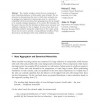Free Online Productivity Tools
i2Speak
i2Symbol
i2OCR
iTex2Img
iWeb2Print
iWeb2Shot
i2Type
iPdf2Split
iPdf2Merge
i2Bopomofo
i2Arabic
i2Style
i2Image
i2PDF
iLatex2Rtf
Sci2ools
130
click to vote
ALIFE
2005
2005
State Aggregation and Population Dynamics in Linear Systems
We consider complex systems that are composed of many interacting elements, evolving under some dynamics. We are interested in characterizing the ways in which these elements may be grouped into higher-level, macroscopic states in a way that is compatible with those dynamics. Such groupings may then be thought of as naturally emergent properties of the system. We formalize this idea and, in the case that the dynamics are linear, prove necessary and sufficient conditions for this to happen. In cases where there is an underlying symmetry among the components of the system, group theory may be used to provide a strong sufficient condition. These observations are illustrated with some artificial life examples. 1 State Aggregation and Dynamical Hierarchies Many naturally occurring systems are composed of a large collection of components, which interact with each other and possibly with some background environment. These components often cluster into larger units: for example, DNA molecules ...
ALIFE 2005 | ALIFE 2007 | Artificial Life Examples | Strong Sufficient Condition | Sufficient Condition |
Related Content
| Added | 15 Dec 2010 |
| Updated | 15 Dec 2010 |
| Type | Journal |
| Year | 2005 |
| Where | ALIFE |
| Authors | Jonathan E. Rowe, Michael D. Vose, Alden H. Wright |
Comments (0)

